
Image Source: http://resources2.news.com.au
According to The World Energy Council, our planet currently uses approximately 15 trillion kWh of Electricity per year, representing just 0.02% of the energy contained throughout the world’s oceans.
Much of this electricity is generated by coal powered plants which are environmentally unfriendly, and contribute significantly to green house emissions.
As a result, people have started using “Green Energy” in the form of Wind Power and Solar Power.
So far, not much Wave Power from the Ocean has been harnessed and utilised.
Wave Power is called “Blue Power” and provides clean renewable energy for both Generating Electricity and for the Desalination of Water.

Image Source: http://2.bp.blogspot.com
In this lesson we look at Wave Energy from the Oceans, and some of the Mathematics associated with “Blue Energy”.
Mathematics associated with Blue Energy includes the following:
1) The pattern of movement of particles in water waves
2) Up and Down Simple Harmonic Motion resulting from the sinusoidal nature of swell waves
3) The use of Parabolic shapes to capture waves and concentrate their energy into a narrow region
4) A Variety of Buoy Shapes for positioning on and below the water surface
5) Clever Geometry of Turbine Blades so that they can generate power when going both forwards and backwards
6) A Variety of Geometrical Arrangements of Energy Capturing blades, buoys, turbines, and paddles designed to interact with ocean waves, and freshwater currents
What Causes Waves
Due to the earth’s rotation on a tilted axis, the planet is heated unevenly, which in turn causes winds to blow to try and re-establish temperature equilibrium.
As wind blows across the ocean, it transfers energy into the water, resulting in ocean waves which we see breaking onto the shoreline.
As waves move towards the coast, they are referred to as “swell”.
When they get close enough to shore to be affected by the bottom of the sea, they rear up into “breakers”, which is what surfers utilise.
It is these ocean swell waves which are the best type of wave to use for Blue Energy technologies.
Wave energy is different to Tidal energy.
Tides are caused by the gravitational pull of the moon and sun, and have a period of around 12 hours, whereas ocean waves have a period of around 10 seconds.
The “Period” is the time for the wave to rise and fall and complete its cycle, before it is followed by the next wave.
Due to these vast differences in Waves and Tides, the technology required to extract this energy is extremely different.
Although some scientists are looking at using tides to generate Blue Energy, most of the work is being done on obtaining energy from oceam swell waves.
Water Wave Motion

Image Source: http://upload.wikimedia.org
Waves cause the water particles to travel up and down in elliptical paths, with the maximum kinetic energy happening as the height of the wave passes through the average sea level.
You can feel this constantly varying effect when floating in the surf zone, as it pulls you back and forward, and up and down.
The wave is a disturbance which moves through the water heading toward the shoreline, but the water particles do not move into the shore; they merely bob up and down in the one spot.
This difference and the mathematics associated with it are illustrated in the following diagram:
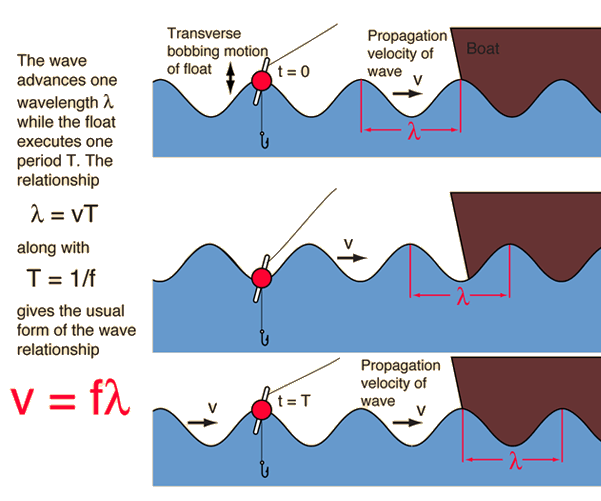
Image Source: http://hyperphysics.phy-astr.gsu.edu
Ways of Capturing Blue Energy
Currently, there are three main ways of capturing Blue Energy :
1) Oscillating Water Column or “OCW” Technology
2) Buoys Bobbing Up and Down
3) A Sea Snake like structure of joined cylinders, which move with the waves in a cantilever fashion
The following five minute Video demonstrates the workings of these three main types of Wave based Power Generators:
[youtube=http://www.youtube.com/watch?v=bEfrtAOMuvk&w=550&h=413]
Oscillating Water Column “OWC” Technology
The above photo is of the Blow Hole at Kiama in New South Wales Australia.
Waves wash up to a cliff face into a Parabolic shaped opening, which concentrates their energy into a tunnel which links up with a vertical shaft in the rock.
Air and Water are forced up this shaft, resulting in a spectacular plume of spray being release up through an elliptical opening in the rock.
As the wave recedes, air is also sucked back down the shaft.
Engineers at Oceanlinx Australia have replicated the blowhole effect into machinery which has a two-way turbine attached to the top of the air shaft.
This turbine spins continuously generates electricity.
The wave capturing intakes are also Parabolic shaped and are claimed to be able to concentrate a 2m swell to produce the input effect of a 6m swell.
Here are what the Oceanlinx “OCW” production units look like in the Ocean.

Image Source: http://static.offshorewind.biz
The equipment has been trialled at Port Kembla on the Australian Coast, and is going into production trials supplying electricity to the city of Adelaide.
The following is a five minute Beyond Tommorrow YouTube Video about the Ocenalinx OCW Technology.
It shows the Kiama Blow Hole in action, and near the end it mentions the Parabolic Wave Trapping unit concentrating the energy by a factor of 3, eg. a 2m swell becomes a 6m swell.
[youtube=http://www.youtube.com/watch?v=z5oOMmcqT8o&w=550&h=413]
The oceanlinx website is well worth checking out, and can be found at the following link:
OWC Breakwater Generator
OWC Technology is also being used in Scotland.
The application of the generator unit is in the form of a breakwater.
The Geometry of the breakwater structure has been optimised to trap the power from the waves and force it to push air back and forth to continually drive the power generating turbine.
The following three minute YouTube video explains fully the workings of the Scottish OCW Generator.
[youtube=http://www.youtube.com/watch?v=gcStpg3i5V8&w=550&h=309]
Fluid Piston Pump Technology
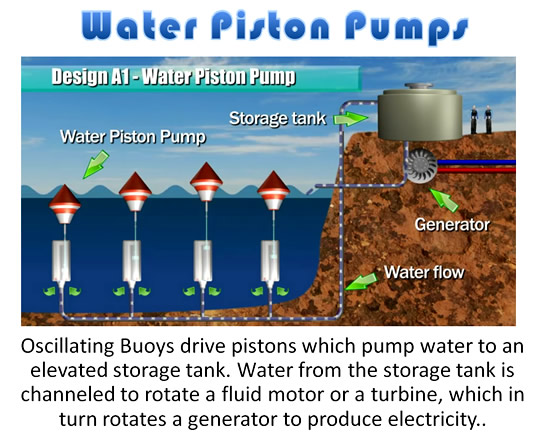
Photo Source: http://www.lamtengchoy.com
This Blue Energy technology has been developed by Henry Lam Teng Choy in Singapore.
Website: http://www.lamtengchoy.com/main/
This method of harnessing wave power uses “Fluid Piston Pumps” driven by energy from ocean waves, or from flowing river currents, and converts this energy into electricity.
Each piston pump is driven by a float; the pumped fluid (water and/or air) is supplied to drive a fluid motor or a turbine, which in turn operates a generator to produce electric power.
Henry owns international patent PCT/SG2011/000232 filed on July1, 2011.
He is starting to receive increased attention in the renewable energy industry and research community, but is yet to receive sufficient capital funding to bring his generators to the market place.
What is particularly amazing is the number of different trapping mechanisms and geometry which has been proposed for the piston pump technology.
Here are just a few of them:

Image Source: http://www.lamtengchoy.com
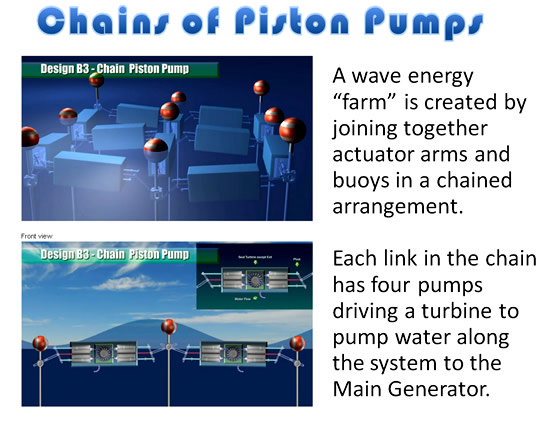
Image Source: http://www.lamtengchoy.com
The following five minute video details and explains all of the different geometric configurations which utilise wave driven piston pumps pumping water to drive an elctricity generating master turbine.
[youtube=http://www.youtube.com/watch?v=fYfs-qYGzvs&w=550&h=309]
CETO Underwater Buoys System
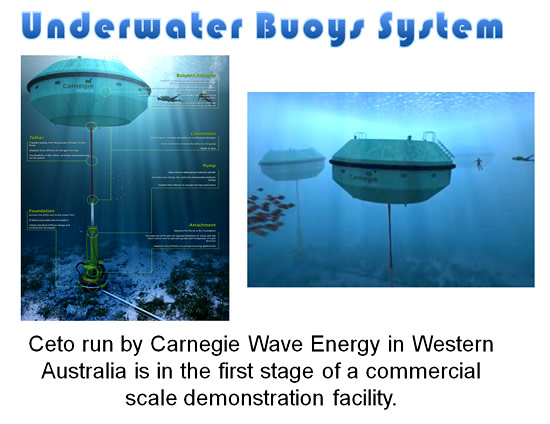
Photo Source: http://www.carnegiewave.com
Carnegie Wave Energy in Western Australia has a non-visual impact underwater system, which pumps water ashore into a combined Desalination Plant / Electricity Generator.
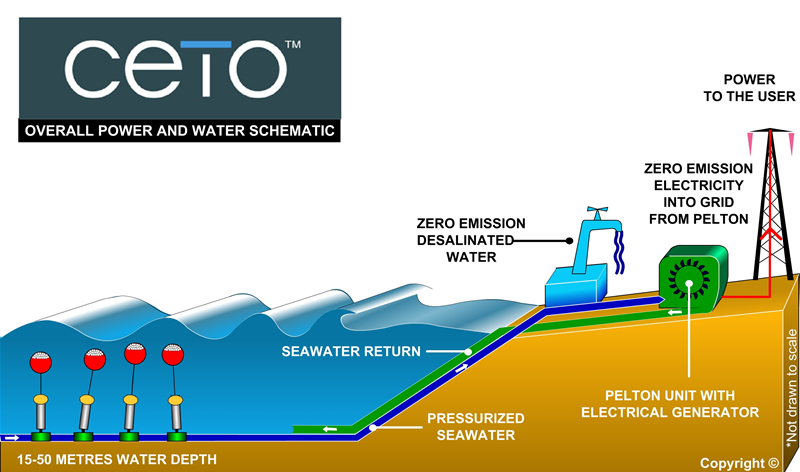
Image Source: http://www.energy.edu.au
Click the above Image to view it full size.
The following one minute video provides an overview of the CETO system.
[youtube=http://www.youtube.com/watch?v=mhDl5HG6vOQ&w=550&h=309]
Here is a longer four minute video about CETO.
[youtube=http://www.youtube.com/watch?v=q0tNneszP5w&w=550&h=309]
There is a full set of 35 videos on CETO at the following You Tube Channel Link:
http://www.youtube.com/user/carnwave/videos
There is also a company website at the following link:
Carnegie are currently commercially trialling the CETO Buoy system by powering the Naval Base on Garden Island at Perth, as well as supplying desalinated fresh water to the island.
Advantages of Wave Energy
Wave energy can be predicted several days in advance, meaning it can be used for base-load power when utilised in an appropriate mix of energy generation sources.
The supply of wave energy and demand for power are well matched, with most of the world’s population living near to the coast.
There are wave energy converters on the market that have no negative impact on its environment and in fact can be beneficial to its environment by acting as artificial reefs and encouraging growth.
Power is provided by Blue Energy Wave Technology night and day, with waves being a far more reliable and regular source compared to Wind and Solar Energy.
When compared to other power generating resources Wave energy is a denser energy medium with higher predictability than wind and solar energy.
There are a wide-ranging number of potential sites to utilise wave energy, while many other resources are limited when it comes to large scale energy production.
Wave energy converters can have less visual impact on its environment during energy production or recovery in comparison to wind and fossil fuels.
Information Source: http://www.oceanlinx.com
Issues and Challenges With Wave Power
Wave power, like other early energy sources, is currently expensive.
While coal might be priced at five to 10 cents per kilowatt hour of energy, wave energy costs reach 20 to 30 cents.
The question is, “How quickly does that come down?”
In the United States, wave power companies need more research and development funds and greater subsidies.
Wave energy companies need more time to develop technologies that can withstand the harsh ocean environment.
Another tricky issue is property. Unlike building a power plant on land a company owns, the ocean is common space.
And although some believe the environmental issues related to wave power are less so than with other technologies, there are still Environmental Unknowns, such as how ecological systems will be affected by wave technologies and how shipping and fishing activities will be affected by device placement.
Information Source: http://www.smartplanet.com
Picture Credits
Electricity Coal Power Station – http://resources2.news.com.au
Oceanlinx Offshore Power Plant – http://2.bp.blogspot.com
Piston Pump Generartors – http://www.lamtengchoy.com
Kiama Blow Hole – http://www.visitnsw.com
Kiama Blow Hole Entrance – http://warragambadamspill.blogspot.com.au
OWC UNit in Scotland – http://www.voith.com
Scottish OWC Diagram – http://news.bbc.co.uk
CETO Buoys – http://www.carnegiewave.com
CETO Diagram – http://www.energy.edu.au
MAV Conference PowerPoint
To download the PowerPoint Presentation from the Mathematics Association of Victoria Conference, click the link below and save the file to your computer.
Click the link below to download this 3MB PPT File:
http://passyworldofmathematics.com/MAVconfPPTs/WavePowerPPTv2.pptx
Related Items
Ocean Mathematics – Overview
Mathematics of Ocean Waves and Surfing
Surfboard Geometry and Design
Tsunami Mathematics
Shark Mathematics
Mathematics of Ships at Sea
Subscribe
If you enjoyed this lesson, why not get a free subscription to our website.
You can then receive notifications of new pages directly to your email address.
Go to the subscribe area on the right hand sidebar, fill in your email address and then click the “Subscribe” button.
To find out exactly how free subscription works, click the following link:
If you would like to submit an idea for an article, or be a guest writer on our website, then please email us at the hotmail address shown in the right hand side bar of this page.
Feel free to link to any of our Lessons, share them on social networking sites, or use them on Learning Management Systems in Schools.
Like Us on Facebook
Our Facebook page has many additional items which are not posted to this website.
These include items of mathematical interest, funny math pictures and cartoons, as well as occasional glimpses into the personal life of “Passy”.
Check it out at the following link:
https://www.facebook.com/PassysWorldOfMathematics
While you are there, LIKE the page so you can receive our FB updates to your Facebook News Feed.
Help Passy’s World Grow
Each day Passy’s World provides hundreds of people with mathematics lessons free of charge.
Help us to maintain this free service and keep it growing.
Donate any amount from $2 upwards through PayPal by clicking the PayPal image below. Thank you!
PayPal does accept Credit Cards, but you will have to supply an email address and password so that PayPal can create a PayPal account for you to process the transaction through. There will be no processing fee charged to you by this action, as PayPal deducts a fee from your donation before it reaches Passy’s World.
Enjoy,
Passy

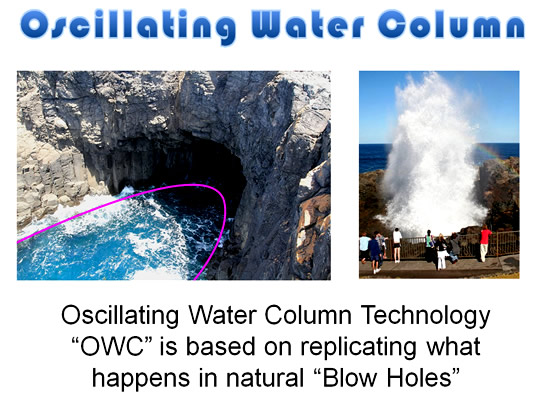
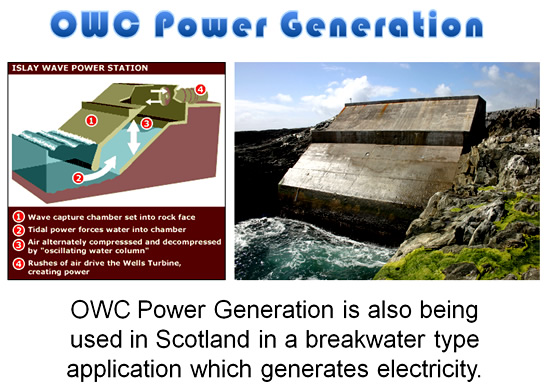


Pingback: Mathematics of Ocean Waves and Surfing | Passy's World of Mathematics
Pingback: Surfboard Geometry and Design | Passy's World of Mathematics
Pingback: Ocean Mathematics | Passy's World of Mathematics
Pingback: Mathematics of Ships at Sea | Passy's World of Mathematics